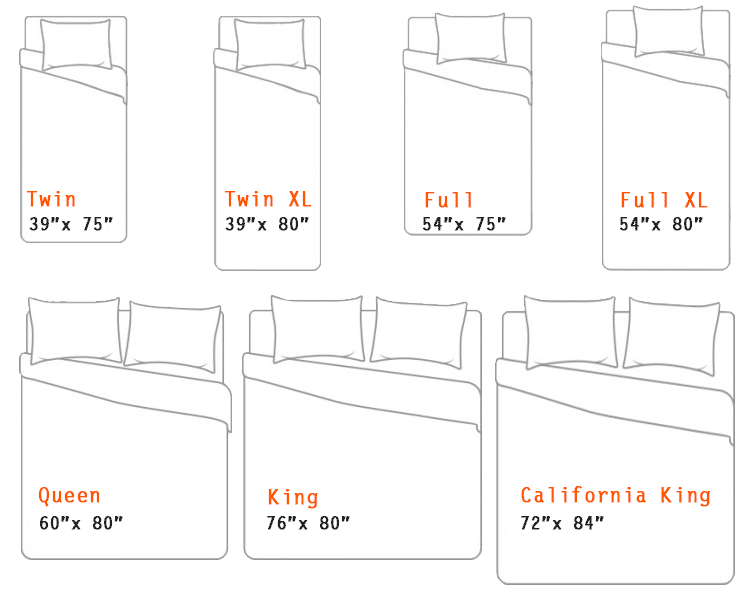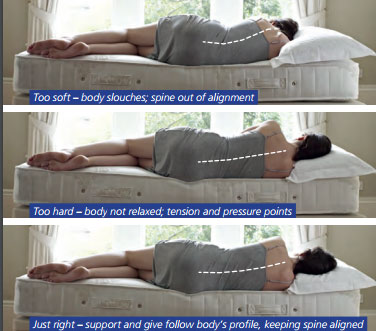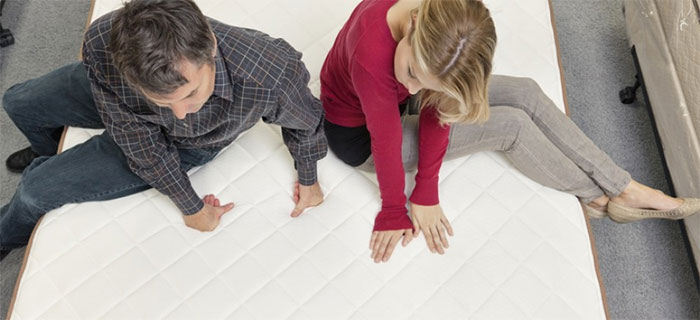How to choose the best bed
Is it time for a breakup?
 There comes the point when you simply have to say goodbye. Things just aren’t working out for you anymore. Unfortunately, for most of us, it’s a tough call to make. How do you know when it’s time to break up with your mattress?
There comes the point when you simply have to say goodbye. Things just aren’t working out for you anymore. Unfortunately, for most of us, it’s a tough call to make. How do you know when it’s time to break up with your mattress?
Despite how comfortable your bed feels, it doesn’t always equate to getting quality sleep. Because of constant use, wear and tear are inevitable. At some point, your bed will no longer be able to give your body the adequate support it needs for a restful sleep. Below are some warning signs that indicate it’s time to replace your bed.
- Waking up is a pain, and not just because you don’t want to face the stresses of the day. If parts of your body are stiff, numb, or aching whenever you wake up on a regular basis, then your body is not getting the support it needs while you’re lying down.
- You’re always tired even after 8 hours of sleep each night.
- You get more sneezes in the morning than snores at night.
- If you keep waking up with unexplained allergies, it might be that your bed has become a “bed” of dead skin cells, sweat, and dust mites.
- You sleep better and wake up more refreshed when you’re away from home. Any bed (or even couch) other than yours enables you to get a restful sleep.
- Some lumps or sagging are visible on your mattress.
A third of our lives is spent sleeping. Degradation of the mattress is an expected outcome. The visibility of the wear and tear simply means you need to take action now rather than later.
If any of these indicators are true for you, it’s time for you to get off your bed and find a new one.
Bed Shopping
Before you go out to find the mattress of your dreams, you’ll need to stop and think about the features of this bed should be. Below are some points that you might want to consider.
Type. What kind of mattress do you prefer – an innerspring mattress with that extra bounce or a memory foam mattress that gives you that “hugging” feeling while you sleep? Also, what level of firmness do you like in your bed – soft, medium, or firm? Keep in mind that there is no industry standard when it comes to firmness levels, and comfort is highly subjective.
Size. As in almost every case, size always matters. The idea size of your bed should be around 10 to 15 cm longer than you. If you’re sharing a bed with your partner, the bed should be large enough that you can lie side by side with approximately 10 cm between you, so you each have enough personal space. Both of you will be comfortable and less likely to disturb each other. Another thing to take note of when it comes to size is dimensions. While a lot of beds have the same name for sizes – King, Queen, Double, etc., it does not mean that they will have the same actual dimensions because there is no industry standard for bed sizes either. Make sure to measure the size of the bed you’ll need and check the dimensions of your potential mattress mate before buying.
 Base and Mattress. The type of base can affect the feel of a mattress. If you’re buying a mattress and not a base, make sure that you try out your potential dream bed on the same type of base you have to get the “real” experience. You also need to keep in mind that, In some cases, using an old base not designed for your new mattress can invalidate your warranty. To be safe, you might want to think about buying both a base and a mattress, two pieces that were specifically designed to work well together.
Base and Mattress. The type of base can affect the feel of a mattress. If you’re buying a mattress and not a base, make sure that you try out your potential dream bed on the same type of base you have to get the “real” experience. You also need to keep in mind that, In some cases, using an old base not designed for your new mattress can invalidate your warranty. To be safe, you might want to think about buying both a base and a mattress, two pieces that were specifically designed to work well together.
 Lifestyle. To ensure that you get your dream bed, you will also have to consider several factors based on your lifestyle. What sleep style do you have – slide, stomach, or back? What about your partner? Do you tend to get hot when you sleep? Do you have any allergies? How much do you and your partner weigh? Do you or your partner move around a lot when you sleep? Are you looking for a bed that’s built for adventurous sex? The answers to these questions will help you further pinpoint which mattress will work best for you.But regardless your sleeping preferences the mattress should mold to the shape of your body and remain supportive.
Lifestyle. To ensure that you get your dream bed, you will also have to consider several factors based on your lifestyle. What sleep style do you have – slide, stomach, or back? What about your partner? Do you tend to get hot when you sleep? Do you have any allergies? How much do you and your partner weigh? Do you or your partner move around a lot when you sleep? Are you looking for a bed that’s built for adventurous sex? The answers to these questions will help you further pinpoint which mattress will work best for you.But regardless your sleeping preferences the mattress should mold to the shape of your body and remain supportive.
Lie on your side and ask your partner to evaluate your spine’s alignment. Ideally, it might be straight as shown in the illustration.
The set-up. How easy will it be to get the bed from the retailer to your room? Are there any potential problems regarding access such as a narrow staircase or a tight corner? For consumers who have this problem, you might want to consider beds that are delivered unassembled and will need to be set up. Also, some beds are now delivered rolled-up and vacuum-packed in a box or bag which makes taking it up to your bedroom a lot easier.
Warranty and customer service. Before you get totally sold on the bed of your choosing, make sure that you find the warranty and after sales service to your liking. How long is the warranty? Do they offer free delivery? Are they offering to get rid of your old bed? What about the company’s return policy? If things don’t work out between you and your new mattress, you need to find out how easy it will be to return your bed and get a refund. Some companies offer a trial period (ranging from a couple of weeks to 120 days) and free pickup. Others will require a 15% restocking fee, while some require you to repackage the bed and cart it all the way to the store.
Budget. Mattresses generally cost a lot, at least the really good ones do. Getting the best value for your money does not mean buying the cheapest in the market. It also doesn’t mean that you need to buy the most expensive bed. The first step is to decide what your budget is. Then, buy the best one you can afford that also meets all your requirements. Price and mattress quality have a direct relationship. The higher the price, the better construction, and material the mattress will have, which will mean better support, comfort, and longevity.
Other tips that will help:
Go for a test drive. You can’t rely on a salesperson telling you how soft or firm the bed will feel. You will need to get first-hand knowledge of those facts. Lie down on the mattress in your typical sleeping position for at least 5-10 minutes. Check the comfort level as well as the support that the bed provides. Move into a different sleeping position and stay there for another 5-10 minutes to evaluate the comfort and support level. Don’t let anyone hurry you along. More importantly, make sure you wear comfortable clothes and to take off your shoes and coat before you do any testing.
Note: You can check the firmness level of the bed by lying down on your back and sliding your hand under you, towards the hollow of your back. Sliding your hand too easily means the bed is too firm which may cause too much pressure on your hips and shoulders. Too much resistance means that the bed is too soft. The perfect result should be a bit of resistance, but the hand won’t feel uncomfortable at your back. You can also opt to use keys. If you don’t feel them while you’re lying down, then you found the firmness level that will give you the right kind of support.

If you sleep together, you should buy together. Partners will need to shop for a bed together to ensure that both of their needs are met. It’s even more vital if they are of widely different sizes and/or weight. A huge difference may mean buying a customized mattress – one type of mattress for each individual sewn or zipped together to create one bed.
Secure online shopping. There are plenty of shopping sites that offer mattresses. However, it’s important that you only buy a bed from a reputable site. This means the site should have extra protection in place for online transactions since you’ll be entering your credit card details.
Mattresses Explained
While mattresses may look the same, there is a host of differences that you’ll need to know about before you can make your choice.
Innerspring Mattress
This is one of two main categories of mattresses. Innerspring mattresses have been the traditional choice of bed for years. While there are variations of this type, several components remain the same. All innerspring mattresses will have a comfort layer, a base layer, and a coil configuration. You can learn more about spring mattresses here.
Non-spring Mattresses
Foam mattresses have layers of a particular type of foam with varying densities and thickness to produce a correct level of comfort and support. There are four types of foam used in this kind of mattress – latex, memory foam, gel foam, and polyurethane foam.
Latex
Natural latex is produced from the sap of a rubber tree which makes it a premium material for a mattress. This type of foam mattress is a popular choice due to the comfort and support it provides the sleeper as well as its durability. You can learn more about latex mattresses here.
Memory Foam
Also called visco elastic, this type of foam was initially designed to be used by NASA for seat and crash protection. Memory foam mattresses are known for relieving pressure points, contouring itself around the body shape of the sleeper to provide both comfort and support. To learn more about this type of mattress, visit our memory foam page here.
Polyurethane Foam
Poly-foam, as it is sometimes called, is a synthetic foam derived from petrochemicals and popularly used as a mattress topper or mattress base due to its low cost. This inexpensive foam is very versatile, and its performance will vary depending on the density and quality of the foam used.
Gel
Gel-infused foam is one of the latest sleep innovations, specifically designed to create “cool sleeping.” It is a combination of gel and visco-elastic foam that provides increased airflow while still ensuring excellent support and pressure relief.
Air Mattresses
As the name implies, air mattresses are filled with air. These have adjustable air chambers surrounded by comfortable padding that enables sleepers to customize their bed to meet their needs. One big advantage to this mattress is the lack of sagging since you can quickly pump more air into the bed to increase its firmness. One big disadvantage is that the mattress can pop, just like a balloon. To learn more about air mattresses, click here.
Waterbeds
Obviously, this type of mattress is filled with water. Just like air mattresses, the amount of water inside the bed will dictate the level of support and comfort the bed provides. Waterbeds are a popular choice for those looking for pressure free support or allergy-free beds. An adjustable temperature heater enables you to keep the water warm, so the bed remains cozy for those who prefer it that way.
Futon Mattress
This type of mattress has several layers of cotton or foam that are foldable, enabling you to arrange it into a sofa or a bed. Traditionally, this is a Japanese bedding – a thin mattress easily rolled or folded away for storage during the day. In western countries, a futon is a sofa bed.
Mattress Covers
The cover of a mattress is called ticking, a tightly woven or knitted fabric that was originally used to ensure that all the straw or feathers that made up the bed won’t stick out and scratch the person lying down. Today, ticking on a mattress has a different purpose. Some mattresses’ ticking is simply decorative. Some low-cost covers are polyester clothes with prints on them. Some knitted ones are cheaply done which means they won’t be tough or tear resistant. But a lot of manufacturers nowadays use ticking to offer special features such as anti-allergy, water resistant, naturally fire retardant, antibacterial, breathable, etc.
Mattress Finishes
A mattress is either finished by quilting or tufting. Quilting is when the top layer of the bed is attached to the cover. Aside from creating a decorative effect, quilting also produced a smoother finish and to keep the layers of the bed and cover locked into place. Tufting, on the other hand, secures the top layer to the cover by making use of buttons or stitches to create peaks and valleys on the surface of the mattress while preventing the materials inside from shifting around.
Overlays and Toppers
Toppers, also known as mattress pads, and overlays are simply a thinner version of a mattress that is placed on top of the mattress’ surface layer to provide additional cushion to the sleeper. It must be noted that toppers do not provide correct support, only comfort. These extra layers are often used when an existing bed is showing signs of degradation such as lumps or sagging. To learn more about toppers, click here.
Bed Bases Explained
Finding the right mattress means you’re halfway to your goal of a good night’s rest. Getting a bed base that ensures you get the support and comfort you need is the remaining half. A bed base absorbs some of the weight and stress placed on the mattress whenever it is used as well as gives your mattress a lift. There are different types of bed bases that you can match with your mattress, each one offering extra features such as decor, storage, or adjustability.
Divans
The most popular and simplest type of bed base is the divan which is further divided into several different kinds. A divan is technically an upholstered box with castors, springs, or legs and a matching headboard.
Sprung edge divans make use of a coil system placed on top of the frame (from edge to edge) to help absorb shock or stress and prolong the mattress’ durability.
A platform bed, also known as a solid top divan is just an upholstered wooden frame made from hardboard to provide support to the mattress. This type of bed base is typically matched with an orthopedic mattress.
A firm edge divan is similar to a sprung edge divan because it also features springs mounted on a rigid wooden frame. However, the springs are usually larger, heavy duty, and smaller in number.
A divan is a really good choice for a bed base if you’re tight on space and need storage options. Some divans have drawers while others are ottoman-style bed bases, enabling you to lift up the bed and store stuff inside.
Slatted bases
As the name implies, the bed base comes with slats where the mattress will be placed on top of. The slats are either rigid or flexible (there’s a level of springiness to the slats). It’s important to note that the gaps should not be wider than 3 inches (9-10 cm). A bigger gap between slats will increase the amount of wear and tear on your mattress. Check the manufacturer’s recommendation regarding slat spacing to prevent mattress degradation.
Bedsteads
Bedsteads are bed frames comprised of a legs, base, and headboard. These come in a variety of styles (classic, antique, modern, retro, etc.) and materials (plastic, wood, metal, etc.). Mattress support also varies. It could be slats, a metal grid, or even woven wire.
Adjustable Bases
This type of bed base enables you to change the mattress’ position and height based on your preference, much like beds that you find in the hospital. Depending on the model, sleepers will be able to rest in a raised sleeping position, adjust the position of your feet or legs, and even adjust the mattress below your neck or head.
Bunk Beds
This type of bed base is what is often seen in dormitories or cabins at summer camp. Two-bed frames that occupy a small space.
Headboards
While not essential to a good night’s sleep, headboards do add to the overall look of your bed as well as your room. Choosing the style and material of your headboard is all about preference. Most of the time, a headboard will match or complement the selected bed base.
Pillow Talk
Once you get your bed all sorted out, you come to the final piece of the puzzle – the pillow. Your pillow is essential to your trip to dreamland because a poor choice can mean neck and shoulder pain as well as a restless night. In choosing the right pillow, there are several factors one should consider. This includes size, sleeping position, level of softness, thickness, and filling. To learn more about pillows, visit our page here.
Mattress Care
Like any other product, the lifespan of a mattress will depend on how much you take care of it. Below are some tips to help you care for your bed.
- If you have an innerspring mattress, avoid rolling or bending it because doing so will damage the coils and potentially invalidate the warranty.
- Mattresses need to be flipped every week for the first few months. Then, rotate the mattress every few months to minimize wear and tear in the same locations. If the one you bought was specifically designed for non-turning, make sure to rotate it regularly to avoid lumps and bumps from forming.
- Your new bed won’t feel that comfortable for the first few nights, but it doesn’t mean you made the wrong choice. Your body just needs to adjust to the new surface, and this may take up to a few weeks.
- A mattress protector will increase the durability of your bed by keeping it safe from stains, moisture, dirt, and sweat.
- If you regularly sit on the edge of the mattress when putting on your shoes or trying to wake yourself up, try to make sure you don’t always use the same spot. Doing so could cause the mattress to lose its structure in that location prematurely.

